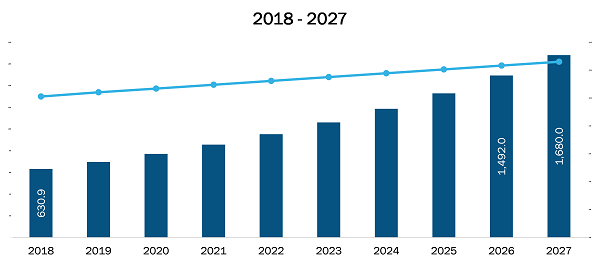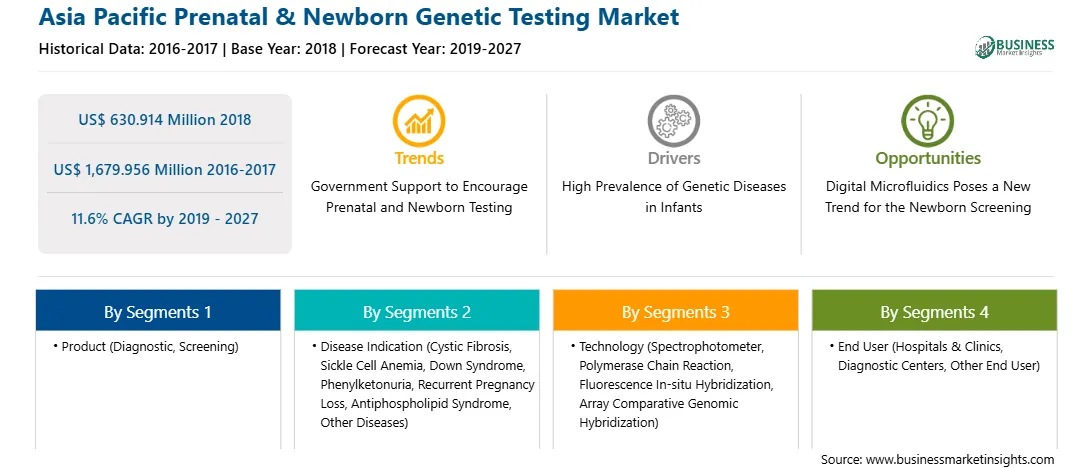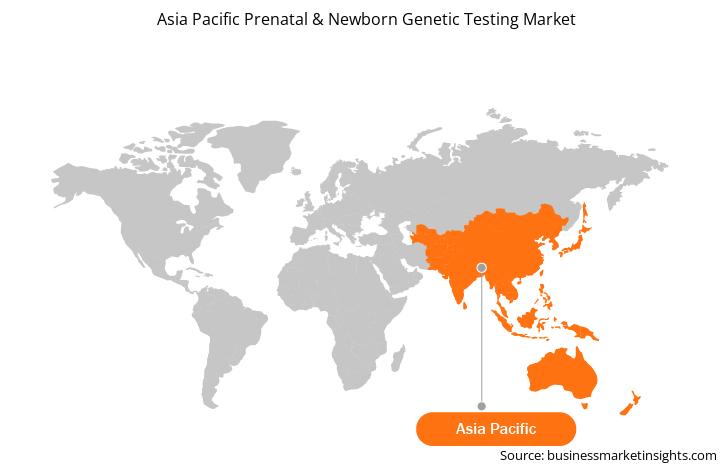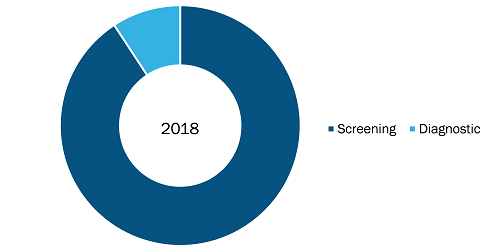The Asia Pacific prenatal and newborn genetic testing market is expected to reach US$ 1,679.956 Mn in 2027 from US$ 630.914 in 2018. The market is estimated to grow with a CAGR of 11.6% from 2019-2027.
The key factors responsible for the growth of the Prenatal and Newborn Genetic testing market in Asia Pacific are rising burden of genetic diseases among infants, increasing fertility rates and developing healthcare scenario with rising awareness among populace regarding the benefits of prenatal testing. On the other hand, use of digital microfluidics in newborn testing is likely to be a prevalent trend in the future years.

Strategic insights for the Asia Pacific Prenatal & Newborn Genetic Testing provides data-driven analysis of the industry landscape, including current trends, key players, and regional nuances. These insights offer actionable recommendations, enabling readers to differentiate themselves from competitors by identifying untapped segments or developing unique value propositions. Leveraging data analytics, these insights help industry players anticipate the market shifts, whether investors, manufacturers, or other stakeholders. A future-oriented perspective is essential, helping stakeholders anticipate market shifts and position themselves for long-term success in this dynamic region. Ultimately, effective strategic insights empower readers to make informed decisions that drive profitability and achieve their business objectives within the market.

| Report Attribute | Details |
|---|---|
| Market size in 2018 | US$ 630.914 Million |
| Market Size by 2027 | US$ 1,679.956 Million |
| Global CAGR (2019 - 2027) | 11.6% |
| Historical Data | 2016-2017 |
| Forecast period | 2019-2027 |
| Segments Covered |
By Product
|
| Regions and Countries Covered | Asia-Pacific
|
| Market leaders and key company profiles |
The geographic scope of the Asia Pacific Prenatal & Newborn Genetic Testing refers to the specific areas in which a business operates and competes. Understanding local distinctions, such as diverse consumer preferences (e.g., demand for specific plug types or battery backup durations), varying economic conditions, and regulatory environments, is crucial for tailoring strategies to specific markets. Businesses can expand their reach by identifying underserved areas or adapting their offerings to meet local demands. A clear market focus allows for more effective resource allocation, targeted marketing campaigns, and better positioning against local competitors, ultimately driving growth in those targeted areas.

Market Insights
Burden of Genetic Diseases in India
Several types of genetic diseases affect the fetuses in the womb. The way in which these genetic diseases are inherited helps to determine the risk that they pose on pregnancy as well as the risk of its recurrence. The risk of having genetic diseases in babies is high in cases where the parents have another child with a genetic disease, family history of a genetic disorder, or if either of a parent has a chromosomal abnormality. There is a significant prevalence of genetic diseases among infants. Moreover, these diseases are also responsible for infant mortality across the globe. Five most common genetic diseases in India affecting the new born are Beta-Thalassemia, Cystic Fibrosis, Sickle Cell Anemia, Spinal Muscular Atrophy and Hemophilia A. Sickle cell anemia is inherited blood disorder and is most common among African, Arabian and Indian population. The Indian pediatrics estimated that every year approximately 9,000-10,000 new born suffer from β-thalassemia. Furthermore, in 2011, India reported 14,718 cases with bleeding diseases and 11,586 patients with hemophilia A.
Furthermore, according to the previous study, “The burden of genetic disorders in India and a framework for community control” in 2002, estimated that approximately, 495,000 new-borns with congenital malformations, 21,400 with Down syndrome, 9,000 with beta-thalassemia, 5,200 with sickle cell disease are born each year. Due to presence of large population, high birth rate, consanguineous marriage in various Indian communities, there is a high incidence of genetic diseases in India. Thus, the high prevalence of genetic diseases among infants account for the increasing demands for prenatal and newborn genetic tests, thereby contributing to the growth of the market.
Development of Policy for Treatment of Rare Diseases
Genetic diseases are, in most cases, chronic, devastating and life threatening, which often requires extensive and specialized treatments. Moreover, these diseases results in some form of disability, which may get extremely severe sometimes. These genetic diseases place a huge psychological, physical, and socioeconomic burden on patients as well as their families. The most common rare diseases are hemophilia, thalassemia, sickle-cell anemia, auto-immune diseases, lysosomal storage disorders and others. Approximately 80% of rare diseases have identified to be of genetic origin and hence have an impact on children.
The government of India (GOI) had constituted committees with the aim of framing a ‘national policy on treatment of 17 rare diseases’. Likewise, the government of National Capital Territory (NCT) of Delhi also appointed an interdisciplinary committee for rare diseases. Following are the committees appointed for rare diseases:
Thus, growing efforts by the Government is likely to boost the market and is expected to provide significant growth opportunities for the prenatal and new born genetic testing market during the forecast period.
Product Insights
The Asia Pacific prenatal and newborn genetic testing market, based on the product was segmented into screening and diagnostics. In 2018, the screening segment held a largest market share of the prenatal and newborn genetic testing market, by product. Moreover, the same segment is also expected to witness the highest CAGR over the coming years owing to the factors such as increasing number of pregnant females adopting prenatal screening, increased mandatory regulations for newborn screening tests and others. Moreover, screens are the first line tests that pregnant women and newborn undergoes that also adds up to the major share of the market and its dominance in the Asia Pacific market.

Strategic insights for the Asia Pacific Prenatal & Newborn Genetic Testing provides data-driven analysis of the industry landscape, including current trends, key players, and regional nuances. These insights offer actionable recommendations, enabling readers to differentiate themselves from competitors by identifying untapped segments or developing unique value propositions. Leveraging data analytics, these insights help industry players anticipate the market shifts, whether investors, manufacturers, or other stakeholders. A future-oriented perspective is essential, helping stakeholders anticipate market shifts and position themselves for long-term success in this dynamic region. Ultimately, effective strategic insights empower readers to make informed decisions that drive profitability and achieve their business objectives within the market.

| Report Attribute | Details |
|---|---|
| Market size in 2018 | US$ 630.914 Million |
| Market Size by 2027 | US$ 1,679.956 Million |
| Global CAGR (2019 - 2027) | 11.6% |
| Historical Data | 2016-2017 |
| Forecast period | 2019-2027 |
| Segments Covered |
By Product
|
| Regions and Countries Covered | Asia-Pacific
|
| Market leaders and key company profiles |
The geographic scope of the Asia Pacific Prenatal & Newborn Genetic Testing refers to the specific areas in which a business operates and competes. Understanding local distinctions, such as diverse consumer preferences (e.g., demand for specific plug types or battery backup durations), varying economic conditions, and regulatory environments, is crucial for tailoring strategies to specific markets. Businesses can expand their reach by identifying underserved areas or adapting their offerings to meet local demands. A clear market focus allows for more effective resource allocation, targeted marketing campaigns, and better positioning against local competitors, ultimately driving growth in those targeted areas.

Strategic Insights
Partnerships, Product up-gradation and product launches were observed as the most adopted strategy in Asia Pacific prenatal and newborn genetic testing industry. Few of the recent partnerships, product launch and up-gradations are listed below;
2019:
Illumina introduced VeriSeq NIPT Solution v2, a CE-IVD, next-generation sequencing (NGS)-based approach to noninvasive prenatal testing (NIPT). The automated comprehensive solution allows laboratories to screen for a broader range of chromosomal and sub-chromosomal conditions associated with birth defects and adverse pregnancy outcomes than the standard NIPT menu.
2017:
Natera, Inc. upgraded its Panorama non-invasive prenatal test (NIPT) to screen twin pregnancies for zygosity (identical or non-identical/fraternal) and chromosomal abnormalities.
2015:
SRL Diagnostics has introduced a breakthrough medical test to diagnose hypertensive disorders in pregnancy recently at its state of the art lab in Gurgaon. PLGF (Placental Growth Factor) is used for accurate diagnosis and prognosis of “pre-eclampsia”, a major cause of maternal, foetal, neonatal morbidity and mortality.
2017:
LifeCodexx AG, a non-invasive prenatal DNA testing company in Europe and LifeCell announced a partnership to bring PrenaTesT qNIPTTM testing for the first time to India. The qNIPT technology detects the presence of fetal trisomy 21 (Down syndrome) from maternal blood.
PRENATAL AND NEWBORN GENETIC TESTING – MARKET SEGMENTATION
By Test Type
By Product
By Disease Indication
By Technology
By End User
By Geography
Company Profiles
The List of Companies - Asia Pacific Prenatal and Newborn Genetic Testing Market
The Asia Pacific Prenatal & Newborn Genetic Testing Market is valued at US$ 630.914 Million in 2018, it is projected to reach US$ 1,679.956 Million by 2027.
As per our report Asia Pacific Prenatal & Newborn Genetic Testing Market, the market size is valued at US$ 630.914 Million in 2018, projecting it to reach US$ 1,679.956 Million by 2027. This translates to a CAGR of approximately 11.6% during the forecast period.
The Asia Pacific Prenatal & Newborn Genetic Testing Market report typically cover these key segments-
The historic period, base year, and forecast period can vary slightly depending on the specific market research report. However, for the Asia Pacific Prenatal & Newborn Genetic Testing Market report:
The Asia Pacific Prenatal & Newborn Genetic Testing Market is populated by several key players, each contributing to its growth and innovation. Some of the major players include:
The Asia Pacific Prenatal & Newborn Genetic Testing Market report is valuable for diverse stakeholders, including:
Essentially, anyone involved in or considering involvement in the Asia Pacific Prenatal & Newborn Genetic Testing Market value chain can benefit from the information contained in a comprehensive market report.